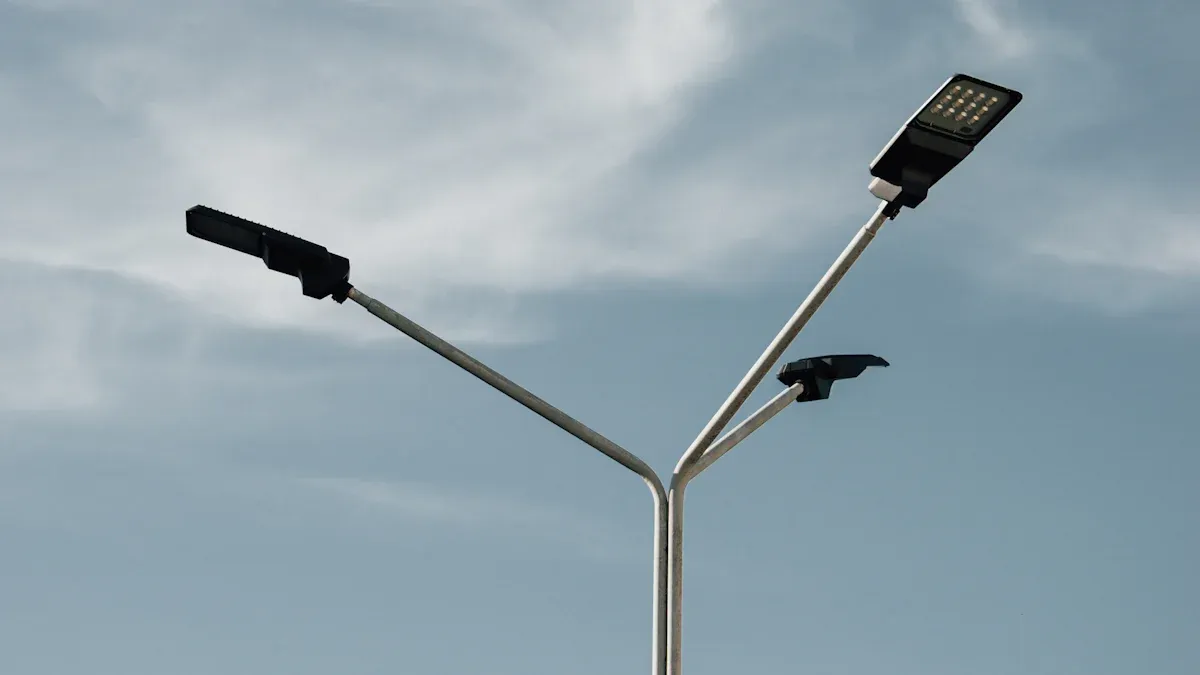
The demand for energy-efficient outdoor solutions continues to rise across the EU and US. Solar light innovations play a pivotal role in this shift. Recent data highlights the global outdoor solar LED market’s projected growth from $10.36 billion in 2020 to $34.75 billion by 2030, driven by a 30.6% CAGR. Favorable policies and incentives further accelerate adoption, creating opportunities for businesses to innovate and meet sustainability goals.
Key Takeaways
- The solar light market is growing fast and may hit $34.75 billion by 2030. Companies need to create new ideas to keep up.
- Smart tech like IoT in solar lights makes them work better and easier to use. Businesses should spend money on these upgrades.
- Using earth-friendly materials in solar lights matches what people care about and helps the planet. Companies can get more buyers by focusing on green choices.
Key Drivers of the Solar Light Market in 2025
Impact of Policy Changes and Regulations
Policy changes and regulations play a significant role in shaping the solar light market. I’ve observed how government initiatives worldwide are driving the adoption of sustainable lighting solutions. For instance:
- Kenya’s Green Energy City Program has replaced traditional lighting with solar streetlights, cutting infrastructure costs and improving illumination in remote areas.
- India’s National Solar Mission promotes solar lamps to address electricity shortages in underserved regions.
- The European Union’s Green Deal, targeting carbon neutrality by 2050, has accelerated the demand for solar lighting.
- The U.S. Inflation Reduction Act provides tax incentives and financial support, making solar lighting projects more affordable and competitive.
These policies create a favorable environment for businesses to innovate and expand their solar light offerings.
Advancements in Solar Lighting Technology
Technological advancements continue to redefine the solar light industry. I’ve noticed how innovations are improving efficiency and reliability. High-efficiency bifacial solar panels and all-solid-state batteries now offer better energy utilization and durability. Intelligent lighting systems, integrating IoT and energy management technologies, provide personalized solutions for users. Additionally, eco-friendly materials like stainless steel with triple-anti-coating technology enhance weather resistance and product longevity. These advancements make solar lighting more appealing to both consumers and businesses.
Consumer Preferences for Sustainable Solutions
Consumer preferences are shifting toward sustainable and smart solutions. Recent studies highlight key drivers behind this trend:
| Evidence Type | Description |
|---|---|
| Demand Drivers | The need for smart, eco-friendly home systems is boosting solar light demand. |
| Consumer Awareness | Awareness of carbon emissions is influencing the adoption of sustainable lighting. |
| Government Policies | Supportive policies encourage consumers to choose solar lighting products. |
This growing demand for sustainable solutions presents a unique opportunity for businesses to align their products with consumer values.
2025 Trends in Solar Light Solutions

Integration of Intelligent Lighting Technologies
I’ve observed a significant shift toward integrating intelligent technologies into solar lighting systems. Manufacturers now embed smart features like IoT sensors, proximity detectors, and app-based controls into their products. These advancements enhance energy efficiency and user convenience. For example, smart battery systems now allow real-time monitoring of charge levels and energy consumption. This optimization ensures better energy utilization and longer system life.
The rise of smart cities further accelerates this trend. Solar lighting systems increasingly connect with intelligent infrastructure, enabling remote monitoring and automated adjustments. A recent study highlights how these innovations improve public safety and reduce operational costs. The integration of intelligent lighting technologies represents a pivotal step in making solar light solutions more adaptable and efficient.
Adoption of Eco-Friendly and Recyclable Materials
Sustainability remains a top priority in the solar lighting industry. I’ve noticed that companies are focusing on eco-friendly materials to minimize environmental impact. For instance, the solar street lighting market now emphasizes renewable energy sources and recyclable components. Products like the ST57 Solar LED Street Light showcase this commitment to green innovation.
Collaborations between industry leaders, such as Sunna Design and Schréder, further drive the adoption of environmentally-friendly solutions. These partnerships aim to create durable, recyclable solar light products that align with global sustainability goals. By prioritizing eco-friendly materials, businesses can meet consumer demand for greener alternatives while reducing their carbon footprint.
Expansion into Multi-Scenario Outdoor Applications
The versatility of solar lighting has expanded its use across various outdoor scenarios. Governments increasingly adopt solar lighting for public spaces like streets and parking lots to cut energy costs and enhance safety. In remote areas, off-grid solar solutions provide reliable and cost-effective lighting options.
I’ve also seen a growing focus on aesthetics and advanced designs. Solar lighting now caters to residential, commercial, and industrial needs, offering visually appealing and functional solutions. Applications range from stadiums and highways to agricultural settings. This expansion highlights the adaptability of solar light systems, making them a preferred choice for diverse outdoor environments.
Strategies for Businesses to Succeed in the Solar Light Market
Leveraging Innovative Technologies
I’ve seen how innovation drives success in the solar light market. Businesses that integrate cutting-edge technologies like IoT and smart systems into their products gain a competitive edge. For example, IoT-enabled solar lighting allows real-time monitoring and remote control, enhancing energy efficiency and user convenience. Companies that develop more efficient and durable solar cells also stand out. These advancements not only improve product performance but also align with consumer demand for sustainable and intelligent solutions.
To stay ahead, I recommend businesses invest in R&D to explore emerging technologies. Collaborating with tech firms can also accelerate the integration of advanced features into solar lighting systems. By leveraging innovation, companies can deliver superior products that meet evolving market expectations.
Diversifying Product Portfolios
Expanding product offerings is another key strategy for success. I’ve noticed that companies like Philips and Gama Sonic focus on diversifying their portfolios to cater to various customer needs. This approach helps businesses tap into residential, commercial, and industrial markets. For instance, offering solar lighting solutions for both urban and off-grid applications ensures broader market reach.
A diverse portfolio also allows businesses to adapt to changing trends. By including products with smart features, eco-friendly materials, and aesthetic designs, companies can attract a wider audience. I believe this flexibility is essential for maintaining relevance in a competitive market.
Strengthening Supply Chain Flexibility
Supply chain resilience plays a critical role in meeting market demands. I’ve observed how disruptions can impact product availability and customer satisfaction. Businesses that build flexible supply chains can respond quickly to challenges. For example, sourcing materials from multiple suppliers reduces dependency on a single source.
Adopting digital tools for supply chain management also improves efficiency. Real-time tracking and predictive analytics help businesses anticipate issues and optimize operations. I encourage companies to prioritize supply chain flexibility to ensure consistent delivery of high-quality solar light products.
Addressing Challenges in the EU/US Solar Light Markets

Competing in a Crowded Market
The solar lighting market is growing rapidly, but this growth brings intense competition. I’ve noticed that North America and Europe lead the market, while Asia Pacific is catching up due to urbanization and electrification initiatives. The market’s projected expansion at a strong CAGR through 2033 highlights its potential, yet it also underscores the crowded landscape.
Businesses face challenges convincing customers to switch from traditional lighting solutions. Many consumers still perceive conventional options as more reliable or cost-effective. To stand out, companies must differentiate their products through innovation, such as integrating smart features or offering customizable designs. Building strong brand recognition also helps businesses gain a competitive edge in this saturated market.
Navigating Regional Policy Variability
Policy differences across regions create hurdles for businesses. In the EU, stringent environmental regulations demand compliance with sustainability standards. Meanwhile, the U.S. offers tax incentives but varies policies by state. This inconsistency complicates market entry and expansion strategies.
I recommend businesses stay informed about regional policies and adapt their offerings accordingly. Partnering with local stakeholders can also help navigate regulatory landscapes. By aligning with regional requirements, companies can avoid compliance issues and build trust with customers.
Balancing Costs with Quality Standards
High initial costs remain a significant barrier for solar lighting adoption. Customers often hesitate due to the upfront investment required. Additionally, weather dependence affects performance, especially in cloudy or rainy regions.
| Challenge | Description |
|---|---|
| High Initial Costs | The initial investment required for solar lighting systems can deter potential customers. |
| Weather Dependence | Efficiency is affected by cloudy or rainy weather, impacting consistent performance. |
| Competition from Traditional Solutions | Traditional lighting solutions still dominate, making it challenging to convince customers to switch. |
To address these challenges, I suggest businesses focus on cost-effective innovations without compromising quality. Offering financing options or warranties can also ease customer concerns. By balancing affordability with reliability, companies can attract more buyers and strengthen their market position.
Understanding the key drivers and trends in solar lighting is essential for staying competitive. The market’s rapid growth highlights its potential. For instance:
- The global solar lighting system market was valued at $5.7 billion in 2020.
- It is projected to reach $13.4 billion by 2027.
| Year | Market Value (in billion USD) |
|---|---|
| 2020 | 5.7 |
| 2027 | 13.4 |
I believe businesses must innovate and adapt to meet EU and US demands. Proactive strategies, such as leveraging advanced technologies and diversifying portfolios, will help capitalize on the growing need for energy-efficient outdoor solutions.
FAQ
What are the key benefits of using solar light for outdoor applications?
Solar light offers energy efficiency, reduced electricity costs, and eco-friendliness. It also provides reliable illumination in off-grid areas, making it ideal for diverse outdoor scenarios.
How can businesses ensure their solar light products meet sustainability standards?
I recommend using recyclable materials, adopting energy-efficient designs, and complying with regional environmental regulations. These steps align products with global sustainability goals.
What factors should consumers consider when choosing solar light solutions?
Consumers should evaluate energy efficiency, durability, and smart features. Additionally, they should consider the product’s suitability for specific outdoor applications and its weather resistance.
Post time: Mar-13-2025
